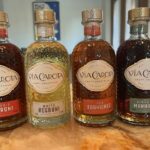
“Napa” is the story of the Napa Valley wine industry.
In fact, it is a composition of many stories. Even though there are dozens of stories, within this book, these are only a smattering of the thousands of individual stories that make the Napa Valley wine industry what it is today.
I have driven through Napa Valley hundreds of times in my real life business as a real estate appraiser. Many times, as well, as a tourist and tasting wine and eating at the many wonderful restaurants. Prior to taking any classes at Napa Valley College in the VWT program, I had seen many of the monuments to the wine industry, built over the past century and a half. Sutter Home, Beringer, Mondavi, Niebaum, Opus and even, Buena Vista in Sonoma Valley. These estates all had complex stories behind them that I never knew about. There were many people that had a significant impact on what the Napa Valley wine industry is today. Jack Davies, Warren Winiarski, Robert and Peter Mondavi, John Daniel, Andre Tchelistcheff and a host of others.
There are also many incidents and happenings that made the Napa Valley wine industry what it is today. The passing of the Ag Preserve ordinance in 1967, the personal and legal battles of Robert and Peter Mondavi and the coming of age of Napa Valley wines with the respectability that was won with the famous Paris tasting of 1973.
Of particular interest to me is the passing of the Ag Preserve Ordinance. This was a hotly contested issue, pitting developers and land owners with a desire to develop agricultural properties into residential and commercial developments against winery and vineyard owners and others with a desire to protect the natural beauty and diverse habitats of the valley.
I can imagine, back in 1967, that this was an extremely divisive issue. At the other end of the San Francisco Bay region, to the south, was San Jose. San Jose was changing from an agricultural economy, to a service and manufacturing economy. In fact, this had started a decade before and the Napa landowners had undoubtedly seen the writing on the wall and the need for bedroom communities to the more developed and increasingly land scarce counties of San Francisco, Alameda and Contra Costa counties. The Napa landowners stood to make handsome retirements that they could pass down to their heirs. Homes were being built in the South Bay at a breakneck pace. Land was the new gold rush in California. Surely the scenic vistas of Napa Valley would be perfect for vast tracts of cookie cutter homes. I can’t say as I blame the landowners of Napa Valley for looking to the South bay as a blueprint for the riches of development in Napa Valley. One of the major factors in the value of real estate is the ability to do with it and develop it as one pleases, subject to local zoning ordinances. Land owners in Napa Valley saw their future land values dwindling with the passing of the Ag Preserve Ordinance.
Of course, as is the case with many things, hindsight is 20/20.
Open space and developable land are not the only things unique to Napa Valley that make the land value what it is.
Napa Valley land is some of the most valuable land in California, not because it can be developed to waves and waves of tract homes on 6,000 sf lots, but because of it’s scarcity. With the ac Preserve Ordinance, minimum lot sizes on the valley floor became 40 acres. This was reduces to 20 acres and later, reversed back to 40 acres. And why was this land so valuable? It was valuable because of a confluence of characteristics that makes the Napa Valley unique in the world.
Climate: Napa County has a climate, and the micro climates within, that make it perfect for growing world class grapes for wine.
Location: Napa County is located just a short drive from the urban areas that provided a base for the tourism industry to get it’s start with.
Scenic beauty: The natural vistas and scenery in Napa Valley make the attraction to visit the area all the greater for tourists far and wide.
Consider other areas of California. There are many that are scenic, Like Del Norte County, for example. Some that are close to the metropolitan areas, like San Bernardino County. Some areas that have great climates. But there are few areas with the combination of the characteristics above, and that creates scarcity. Because the wine industry had yet to hit it’s stride in 1967, these issues and characteristics were known only to a very few people, like Jon Daniel, George Abate and Al Harberger. Against great odds, they finally convinced Supervisor Julius Caiocca to vote in favor of the Ag Preserve Ordinance. The people that had fought hard against this predicted that “in twenty years, no one will even remember this”. This prophecy could not have been more wrong and the fortunes in the Ag Preserves were maintained and made even greater with the passage of the ordinance.
40 years down the road, consider a builder in the San Jose area, or Napa Valley for that matter, within Napa City limits, depending on the project, can build 5-8 homes on an acre of land, depending on the exact zoning. At $100,000 profit per, after each home is sold, a developer can make a tidy profit. The land owner, who sold out to the developer, makes far less, as a general rule. Rutherford Bench Cabernet Sauvignon, in certain blocks, can sell for $20,000-30,000 per ton. That’s about $75,000/acre for the grapes. It doesn’t take long for the land owner who keeps their land producing high quality grapes, to overtake the developer in profitability, in the long run.
The controversy over agricultural preserves continues to this day and will not likely fade away, until Napa Valley land is worthless. And that won’t be any time soon.
Overall, I thought the book was well researched and highly detailed and I would recommend it to anyone wanting to learn the history and people that made Napa valley what it is today.
—
Student of the Grape at Napa Valley College
Soccer Player (Goal Keeper)
Wine Maker (In my own mind)
Facebook Ho (Friend Me!)
Motorcycle Rider (Kawasaki ZZR1200)










Nice write up, Anthony. Coincidentally, I just finished reading this book. Fascinating stuff!